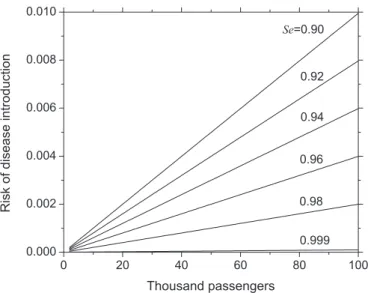543 Rev Bras Epidemiol 2010; 13(3): 543-5
Letter to the Editor
On the Risk of Introduction of an
Emerging Infectious Disease
Marcos Amaku
José H.H. Grisi-Filho
Raul Ossada
Fernando Ferreira
Faculdade de Medicina Veterinária e Zootecnia da Universidade de São Paulo – USP.
Corresponding Author: Marcos Amaku. Faculdade de Medicina Veterinária e Zootecnia da Uni-versidade de São Paulo. Av. Prof. Dr. Orlando Marques de Paiva, 87 – CEP 05508-270, São Paulo, SP, Brasil. E-mail: amaku@usp.br
Dear Editors,
An interesting editorial1 published in Revista Brasileira de Epidemiologia ad-dresses the threat of an inluenza pandemic and mentions “the information technology that makes it possible to monitor the dis-tribution of new cases in real time”. We are aware that the risk of spread of an emerg-ing infectious disease from one country to another depends on the number of travelers and on the ability of the monitoring system to detect infected passengers. In this letter, we describe a quantitative methodology to estimate the risk of introduction of an emerging infectious disease into a disease-free country through the movement of persons between countries in international lights. Our aim is to contribute to the dis-cussion about the importance of factors that inluence the spread of inluenza and other emerging diseases.
Let us suppose that n travelers depart from country A to country B, each of which with a probability p of being infected by an emerging infectious disease occurring in A. The proportion of infected persons (popu-lation prevalence) in A would give a rough estimate for probability p. An additional assumption is that the probability p that a passenger is infected does not depend on the probability that another passenger gets infected in the country of origin. Approxi-mately, there is a probability (1 – p)n that all
n persons are not infected. Therefore, the probability of introduction of at least one infected person in the destination country B
may be estimated as 1 – (1 – p)n. This would be the risk of disease introduction in the absence of an active surveillance system to detect disease.
544
Rev Bras Epidemiol 2010; 13(3): 543-5
On the Risk of Introduction of an Emerging Infectious Disease Amaku, M. et al.
Similar approaches to the model presented here have been applied to data for severe acute respiratory syndrome (SARS)2 and to risk assessment for animal import3. To illustrate the usefulness of this method, Figure 1 shows the results of some calculations using the above equation for p = 10-6, Sp = 1.0, and some values of Se. The risk of disease introduction increases as n increases, and decreases as Se increases. Note that, for Sp < 1.0 or for values of Se lower than those used in the calculations, risk estimates would be even greater than the values observed in Figure 1.
It is dificult to obtain a reliable estimate of p in a timely manner. We assume that, based on data on the previous occurrence of similar diseases and/or on expert opinion, it is pos-sible to estimate an upper bound for the probability pof a traveler being infected (worst scenario). We then may estimate the risk of introduction of at least an infected person quantitatively, on the basis of the inlux of travelers from another country.
It is possible to extend the preceding equation to estimate the risk considering the inlux of passengers from several countries, by multiplying (NPVi)nifor each country i and subtracting the result from 1, obtaining
in which ni(i = 1, 2, …) is the number of travelers arriving from a country with prevalence
pi(i = 1, 2, …).
The sensitivity of a surveillance system may be estimated based on the number of non-detected infected persons (i.e. false negatives) entering the country during recent pandemics, such as the inluenza virus A (H1N1) 4. The disease incubation and infectious
Figure 1 – Probability of disease introduction for p = 10-6, Sp = 1.0, and diferent values of Se
(numbers over the lines), as a function of the number of passengers.
545 Rev Bras Epidemiol 2010; 13(3): 543-5
On the Risk of Introduction of an Emerging Infectious Disease Amaku, M. et al.
periods are factors that affect the sensitivity of the surveillance system. False positives (e.g., persons infected with diseases with similar symptoms) may be detected, resulting in a certain speciicity. Estimates for the sensitivity and speciicity of screening tests, such as thermal scanners used in airports, will probably be available in the future.
Given estimates for Se and Sp, the risk will be a function of the expected number of travelers arriving in a period. Estimates for the risk of disease introduction may help public health oficials to decide whether or not to screen passengers arriving at the beginning of an outbreak. Furthermore, depending on Se and Sp, screening tests may lower the risk of an early introduction of a higher number of infected persons.
References
1. Carvalheiro JR. Popular pandemic. Rev Bras Epidemiol
2009; 12(2): 101-4.
2. Dell’Omodarme M, Prati MC. The probability of failing in detecting an infectious disease at entry points into a country. Statist Med 2005; 24: 2669-79.
3. Murray N. Handbook on import risk analysis for
animals and animal products. Vol. 2: Quantitative risk
assessment. Paris: World Organisation for Animal Health (OIE); 2004.
4. World Health Organization. Inluenza A (H1N1).
Available from http://www.who.int/ csr/disease/
swinelu/en/index.html [Acessed on 05 June 2009].
